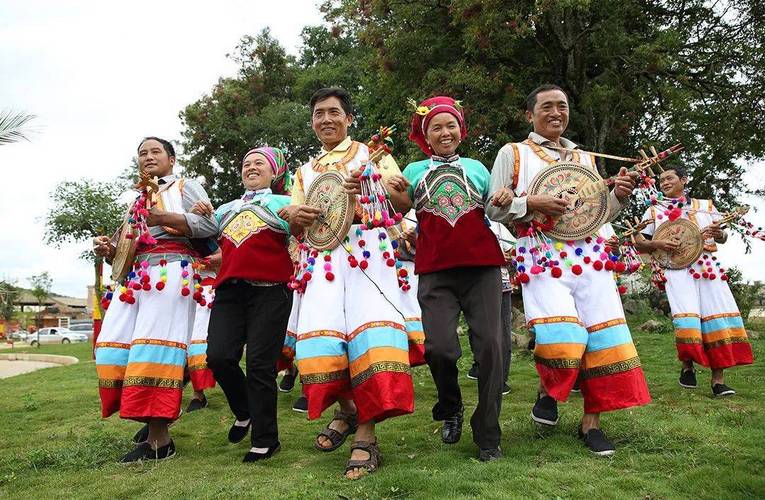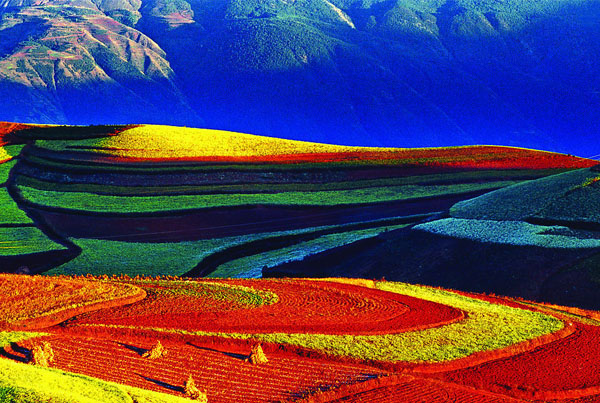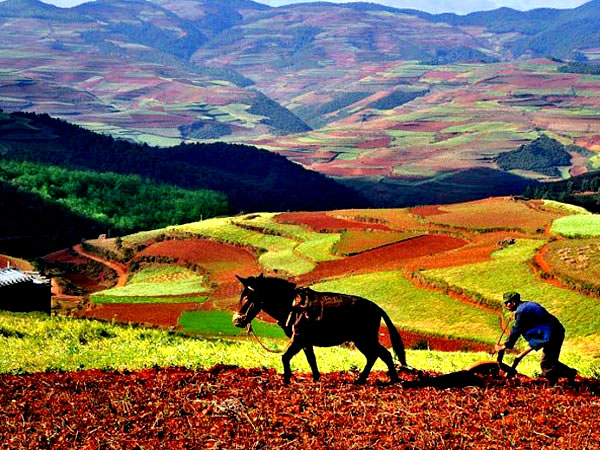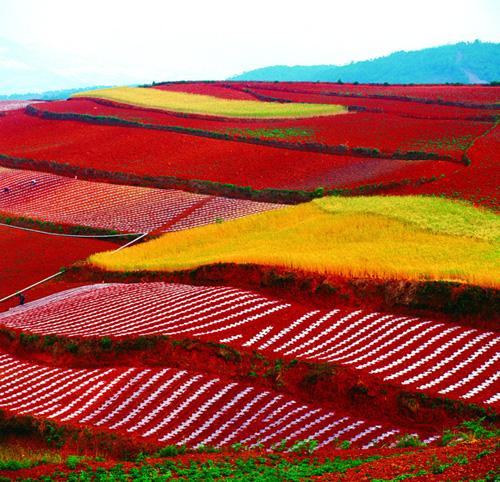
Dongchuan District Overview
1. Basic Information
●Chinese Name:东川红土地
●Key Words:God's palette
●Altitude:1,800–2,600 meters
●Opening Time: the whole day
●Recommended Visiting Time: 1 or 2 days
2. Geographic Conditions of Dongchuan Red Land
Red Earth is a kind of low yield barren soil, mainly because of human and natural weather factors accelerated "red soil desertification". Due to much people and less land, excessive development, deforestation, combined with the characteristics of the soil itself, the soil productivity of red soil area reduced and soil erosion is serious. Severe degradation happens in many regions, forming the "red desertification". Steep slope land reclamation or excessive reclamation, or destroying forest for reclamation, destruction of surface vegetation leads to soil erosion and land degradation. In addition, in the southern mountain area hills, soil erosion is serious and the harm is greater than the loess plateau that the rocky exposed can not be recovered and forms a "red desert".
3. What to See in Dongchuan Red Land
●Sunset Valley(Luoxiagou 落霞沟):Surrounded by mountains, Luoxiagou looks like a sunken depression from a distance. Traditional local villages adorn the colorful fields.
●The 'Hit Horse Hole' Sunrise(Damakan 打马坎):A large spread of red fields are in the arms of continuous mountains at the skyline.
●The 'Tiled House Bridge' Sunset(Wafang Liangzi 瓦房梁子):the best place to see a sunset with Dongchuan's red fields.
●River Snail Bay (Luosiwan 螺蛳湾)the first beautiful red field stop on the way to Dongchuan.
●North River Village(Beihecun 北河村):an untouched village set with a background of a red field hill
|
Sunset Valley |
The 'Hit Horse Hole' Sunrise |
The 'Tiled House Bridge' Sunset |
4. The Best Time to Visit Dongchuan Red Land
●May to JunePhotographers can capture strongly red fields just after ploughing and before the crops grow, and farming photos. Potato flowers opens in the summer and golden wheat decorates the red fields. With various crop colors, red earth, and blue sky, it's one of the best times to get blood red field photos. |
●September to NovemberAutumn is another wonderful season to photo the red fields. Some fields will be turned over for new crops, and there are large expanses of highland barley and wheat. Yunnan's unique white cole flowers make the fields more colorful. This is another good time you should not miss. |
5. Transport inside Dongchuan Red Land
There are no shuttle buses in the Dongchuan Red Land(Earth). Private transport needs to be used in the Red Land because it's big. Luoxiagou and Damakan are around 40 minutes from the hotel. Other attractions are around 10 minutes' drive away.
6. Dongchuan Language
Dongchuan Red Land(Red Earth) is still undeveloped for foreign travelers. Local people can't speak English at all. It's a minority area, where their Mandarin is not so good either. To hire an English-speaking driver is extremely difficult. We arrange an experienced local driver and an English-speaking guide for your tour.
7. Culture
Tangdan Town in Dongchuan District is the main production area of Dongchuan Copper Mine and the seat of Dongchuan Mining Bureau. It has a long history of copper mining and is a veritable "hometown of Qianwang" and "the first town of Dian bronze”. In the course of more than two thousand years of copper mining history, it has gradually formed “Tongshan Spirit”, which is hard working, dedicated, United and tolerant.
8. Economy
In 2010, Dongchuan's GDP was 4.657 billion yuan, with an average annual growth of 27.70.The per capita GDP reached 16485 yuan, with an average annual growth rate of 27.6 yuan.
9. Tourism
Dongchuan is rich in tourist resources. Dongchuan enjoys natural attractions left in different periods, such as Dongchuan Red Land, Dagu Niuzhai Mountain, Guniushan Mountain and Xiaojiang Mudslide Wonder.

 7 Days GolfingTour
7 Days GolfingTour
 8 Days Group Tour
8 Days Group Tour
 8 Days Yunnan Tour
8 Days Yunnan Tour
 7 Days Shangri La Hiking
7 Days Shangri La Hiking
 11 Days Yunnan Tour
11 Days Yunnan Tour
 6 Days Yuanyang Terraces
6 Days Yuanyang Terraces
 11 Days Yunnan Tour
11 Days Yunnan Tour
 8 Days South Yunnan
8 Days South Yunnan
 7 Days Tea Tour
7 Days Tea Tour
 8 Days Muslim Tour
8 Days Muslim Tour
 12 Days Self-Driving
12 Days Self-Driving
 4 Days Haba Climbing
4 Days Haba Climbing
 Tiger Leaping Gorge
Tiger Leaping Gorge
 Stone Forest
Stone Forest
 Yunnan-Tibet
Yunnan-Tibet
 Hani Rice Terraces
Hani Rice Terraces
 Kunming
Kunming
 Lijiang
Lijiang
 Shangri-la
Shangri-la
 Dali
Dali
 XishuangBanna
XishuangBanna
 Honghe
Honghe
 Kunming
Kunming
 Lijiang
Lijiang
 Shangri-la
Shangri-la
 Yuanyang Rice Terraces
Yuanyang Rice Terraces
 Nujiang
Nujiang
 XishuangBanna
XishuangBanna
 Spring City Golf
Spring City Golf
 Snow Mountain Golf
Snow Mountain Golf
 Stone Mountain Golf
Stone Mountain Golf







